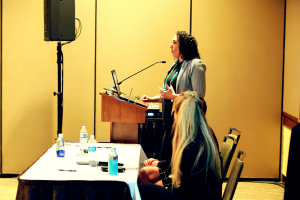
By Autumn Walden, Editor, AACRAO Connect, Content Strategy Manager, AACRAO
In a session for “Institutional Data Simplification,” three leaders from Northeastern University detailed a massive institutional effort that redefined what data simplification can look like in higher education. What started as a technical infrastructure upgrade became a transformative shift in how data supports learners, academic operations, and the university’s future growth.
Presenters Rebecca Hunter, Vice Provost & University Registrar, Thiana Ferry, Deputy Registrar of Operations, and Ingrid Nuttall, Deputy Registrar, shared how Northeastern tackled enormous challenges in a project that took two years and is set to be fully implemented this fall. Still, many of its outcomes, sampled below, are already reverberating across the institution.
Collapsing 18 academic terms into a unified calendar.
Streamlining data definitions.
Simplifying business processes.
‘As simple as possible, only different as necessary’
Hunter, who spearheaded the effort, emphasized a clear guiding principle: simplify wherever possible, but allow for necessary complexity when justified. At Northeastern—a university with global campuses and diverse program formats—inconsistent calendars, duplicate data definitions, and siloed systems were creating confusion, especially for learners.
“We had an undergraduate calendar, but students were taking graduate-level courses, and so they didn't understand,” she explained. “They were missing deadlines; they weren't sure what calendar they were following. Why should they have to figure that out? They were trying to figure us out.”
Hunter knew she had to make the case in two ways:
A student-centered initiative for the university community.
A foundational infrastructure upgrade for leadership.
She aligned the project with an already-planned quarter-to-semester conversion, bundling it with other backend efforts like identity and access management.
The result? A simplification of core data structures and academic calendars that enables learner mobility, improves data literacy, and saves time across the university. Examples of real impact:
Instead of billing students 18 times, now they only have to do it three times.
Consider the reduction in the number of times a semester they had to run Clearinghouse extracts and send them, now just each semester.
This scaling down applies to multiple business processes.
“I put fireworks in this slide because this was fireworks-worthy,” Hunter said, highlighting the consolidation of terms and parts-of-term: from 18 terms to just three (fall, spring, summer), and six standardized parts-of-term within each. “We lifted up the house, changed the foundation, put the house back down so they can keep growing.”
Yet despite the celebratory tone, the team emphasized that this wasn’t a sudden, overnight change but will continue beyond the official project timeline.
From Data to Definitions to Diplomacy
Ferry and Nuttall dove deeper into how the work actually got done. Much of it came down to relationship-building, listening, and framing the project not as a top-down directive, but as a collaborative process.
Ferry advised on pairing critical listening and philosophical approaches with tactical actions from the discovery process through implementation:
Building Consensus.
Learning about student pain points in town halls, Reddit threads, and surveys.
Influencing decision-makers.
Challenging assumptions around institutional data literacy.
Nuttall gave a vivid analogy for those familiar with Apple devices (sidenote: Hunter is an Android user): “Every time you got a new iPhone or a new device, the cords changed? Have you noticed that they're standardized now? Interoperability changed that. Those business processes are a thousand different cords that students have to pick up and figure out which one goes with what device, and they need all of that to pay us the money that they pay us and graduate from the institution.”
One of the key wins was establishing shared definitions for each program modality. The team defined three categories: on-ground, online, and primarily online (programs that include some required in-person components). This clarification solved numerous issues from billing to compliance to student advising.
But defining the terms wasn’t enough. Nuttall shared how she spent over a year socializing those definitions through one-on-one conversations, internal workshops, and the university’s data governance and finance structures. “The big one for me ended up being finance because I did not realize how messy the most core financial processes in reporting for the institution were because of a lack of definition of program modality,” she acknowledged. “And I also learned that it would be incredibly consequential to the institution to change it.”
Institutional change is notoriously difficult, especially when it affects long-standing business practices. The team faced some inertia and hesitation — not resistance, necessarily, but uncertainty about how to begin.
The project’s structure helped. Central IT co-sponsored it as a technical capital initiative, which helped avoid some of the friction that larger-scale reform efforts often generate.
The session ended with a call to action for attendees:
Don’t wait for perfect timing.
Start small.
Listen to the pain points.
Frame simplification in terms of student benefit, not just administrative efficiency.